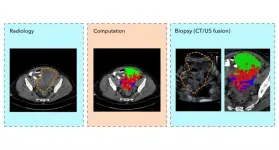(Press-News.org) A new advanced computing technique using routine medical scans to enable doctors to take fewer, more accurate tumour biopsies, has been developed by cancer researchers at the University of Cambridge.
This is an important step towards precision tissue sampling for cancer patients to help select the best treatment. In future the technique could even replace clinical biopsies with 'virtual biopsies', sparing patients invasive procedures.
The research published in European Radiology shows that combining computed tomography (CT) scans with ultrasound images creates a visual guide for doctors to ensure they sample the full complexity of a tumour with fewer targeted biopsies.
Capturing the patchwork of different types of cancer cell within a tumour - known as tumour heterogeneity - is critical for selecting the best treatment because genetically-different cells may respond differently to treatment.
Most cancer patients undergo one or several biopsies to confirm diagnosis and plan their treatment. But because this is an invasive clinical procedure, there is an urgent need to reduce the number of biopsies taken and to make sure biopsies accurately sample the genetically-different cells in the tumour, particularly for ovarian cancer patients.
High grade serous ovarian (HGSO) cancer, the most common type of ovarian cancer, is referred to as a 'silent killer' because early symptoms can be difficult to pick up. By the time the cancer is diagnosed, it is often at an advanced stage, and survival rates have not changed much over the last 20 years.
But late diagnosis isn't the only problem. HGSO tumours tend to have a high level of tumour heterogeneity and patients with more genetically-different patches of cancer cells tend to have a poorer response to treatment.
Professor Evis Sala from the Department of Radiology, co-lead CRUK Cambridge Centre Advanced Cancer Imaging Programme, leads a multi-disciplinary team of radiologists, physicists, oncologists and computational scientists using innovative computing techniques to reveal tumour heterogeneity from standard medical images. This new study, led by Professor Sala, involved a small group of patients with advanced ovarian cancer who were due to have ultrasound-guided biopsies prior to starting chemotherapy.
For the study, the patients first had a standard-of-care CT scan. A CT scanner uses x-rays and computing to create a 3D image of the tumour from multiple image 'slices' through the body.
The researchers then used a process called radiomics - using high-powered computing methods to analyse and extract additional information from the data-rich images created by the CT scanner - to identify and map distinct areas and features of the tumour. The tumour map was then superimposed on the ultrasound image of the tumour and the combined image used to guide the biopsy procedure.
By taking targeted biopsies using this method, the research team reported that the diversity of cancer cells within the tumour was successfully captured.
Co-first author Dr Lucian Beer, from the Department of Radiology and CRUK Cambridge Centre Ovarian Cancer Programme, said of the results: "Our study is a step forward to non-invasively unravel tumour heterogeneity by using standard-of-care CT-based radiomic tumour habitats for ultrasound-guided targeted biopsies."
Co-first author Paula Martin-Gonzalez, from the Cancer Research UK Cambridge Institute and CRUK Cambridge Centre Ovarian Cancer Programme, added: "We will now be applying this method in a larger clinical study."
Professor Sala said: "This study provides an important milestone towards precision tissue sampling. We are truly pushing the boundaries in translating cutting edge research to routine clinical care."
Fiona Barve (56) is a science teacher who lives near Cambridge. She was diagnosed with ovarian cancer in 2017 after visiting her doctor with abdominal pain. She was diagnosed with stage 4 ovarian cancer and immediately underwent surgery and a course of chemotherapy. Since March 2019 she has been cancer free and is now back to teaching three days a week.
"I was diagnosed at a late stage and I was fortunate my surgery, which I received within four weeks of being diagnosed, and chemotherapy worked for me. I feel lucky to be around," said Barve.
"When you are first undergoing the diagnosis of cancer, you feel as if you are on a conveyor belt, every part of the journey being extremely stressful. This new enhanced technique will reduce the need for several procedures and allow patients more time to adjust to their circumstances. It will enable more accurate diagnosis with less invasion of the body and mind. This can only be seen as positive progress."
INFORMATION:
This feasibility study, involving researchers from the Department of Radiology, CRUK Cambridge Institute, Addenbrooke's Hospital, Cambridge University Hospitals NHS Foundation Trust, and collaborators at Cannon, was facilitated through the CRUK Cambridge Centre Integrated Cancer Medicine programme.
The goal of Integrated Cancer Medicine is to revolutionise cancer treatment using complex data integration. Combining and integrating patient data from multiple sources - blood tests, biopsies, medical imaging, and genetic tests - can inform and predict the best treatment decisions for each individual patient.
The study was funded by Cancer Research UK and The Mark Foundation for Cancer Research.
Reference
Lucian Beer, Paula Martin-Gonzalez et al. Ultrasound-guided targeted biopsies of distinct CT based radiomic tumour habitats: proof of concept. European Radiology; 14 Dec 2020; DOI: 10.1007/s00330-020-07560-8
In the future, the Antarctic could become a greener place and be colonised by new species. At the same time, some species will likely disappear. 25 researchers recently presented these and many other findings in a major international project, in which they analysed hundreds of articles on the Antarctic published in the past ten years. By doing so, the team have provided an exceptionally comprehensive assessment of the status quo and future of Antarctica and the Southern Ocean that surrounds it.
Never before have researchers arrived at so many new findings on the biological and biochemical processes at work in the Antarctic than in the past ten years. Now 25 experts, led by the Alfred Wegener Institute Helmholtz Centre for Polar and Marine Research (AWI), have analysed and compiled these ...
Smoking is associated with an increased risk of COVID-19 symptoms and smokers are more likely to attend hospital than non-smokers, a study has found.
The study published today in Thorax, by researchers from King's College London, investigates the association between smoking and the severity of the COVID-19.
Researchers analysed data from the ZOE COVID Symptom Study App. Of the participants of the app, 11% were smokers. This is a lower proportion than the overall UK population of 14.7%, however, it reflects the demographics of the self-selected sample of the ZOE COVID Symptom Study.
While more than a third of users reported not feeling physically well during the period of study (24th March and April 2020), current smokers were 14% more likely to develop the classic triad of ...
DALLAS, Jan. 6, 2021 -- Statins, common cholesterol-lowering medications, may protect women's hearts from damage caused during chemotherapy for early-stage breast cancer, according to new research published today in the Journal of the American Heart Association, an open access journal of the American Heart Association.
"Two types of cancer medications, anthracyclines and trastuzumab, are effective treatments for many women with breast cancer, however, the risk of heart muscle damage has limited their use, particularly in women who are at higher risk for heart problems because of their age or other medical issues," said Husam Abdel-Qadir, M.D., Ph.D., lead author of the study, assistant professor of medicine at the University of Toronto's ...
Toronto - New research from UHN's Peter Munk Cardiac Centre (PMCC) shows statins, commonly prescribed to lower cholesterol and reduce the risk of heart disease and stroke, may also protect the heart from damaging side-effects of early breast cancer treatment.
Published Jan. 6, 2021 in the Journal of the American Heart Association, an observational study found women already taking statins and treated with either anthracyclines or trastuzumab were half as likely to be hospitalized or visit an Emergency Department for heart failure within five years after chemotherapy.
"Our job is to protect the heart and ensure it has the greatest fighting chance to get through chemotherapy," says Dr. Husam Abdel-Qadir, lead author of the paper and a cardiologist at the PMCC and Women's College ...
Separating infants and their mothers after a Caesarean section delivery is common. A new study published in END ...
A reduced sense of smell, or olfactory dysfunction, is one of the most common symptoms of COVID-19. A recent study published the END ...
As children undergo treatment for cancer, they may miss school and risk falling behind in their education. An analysis published in END ...
From 2007 to 2016, food insecurity--or limited access to nutritious foods because of a lack of financial resources--increased significantly from 5.5% to 12.4% among older US adults, and the increase was more pronounced among individuals with lower income. The findings come from a study published in the Journal of the American Geriatric Society.
The study, which drew from data from National Health and Nutrition Examination Surveys, also found that older adults who had food insecurity tended to have lower quality diets.
"Our results provide further evidence that food insecurity is a serious health concern among older adults. Continued investment in public health programs and policies are needed to simultaneously ...
The antimalarial drug hydroxychloroquine is frequently prescribed to treat symptoms of the autoimmune disease lupus. In addition to decreasing disease flares, the drug can also prevent blood clots, which are a major problem in individuals with lupus. A new study in Arthritis & Rheumatology shows that monitoring patients' blood levels of hydroxychloroquine can predict their clotting risk.
In 739 patients, clotting occurred in 38 patients (5.1%). Average hydroxychloroquine blood levels were lower in patients who developed clots, and clotting rates were reduced by 12% for every 200 ng/mL increase in the most recent hydroxychloroquine blood level.
The finding may help clinicians determine the optimal dosing of hydroxychloroquine ...
Individuals face a higher risk of dying following hip fractures. A new study published in the Journal of Bone and Mineral Research has found that living alone after experiencing a hip fracture may further elevate this risk.
For the study, researchers examined information on hip fractures from all hospitals in Norway from 2002 to 2013, and they combined the data with the 2001 National Population and Housing Census.
During 12.8 years of follow-up in 12,770 men and 22,067 women with hip fractures at ages 50 to 79 years, higher rates of death were seen in both men and women living alone versus those living with a partner (a 37% higher risk in men and a 23% higher risk in women).
INFORMATION: ...

